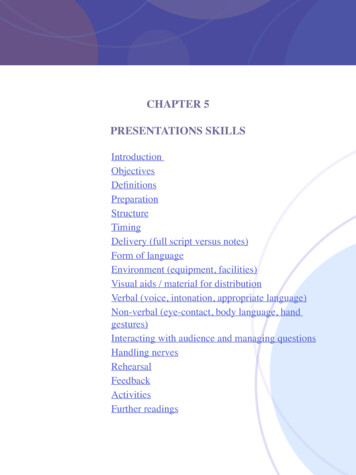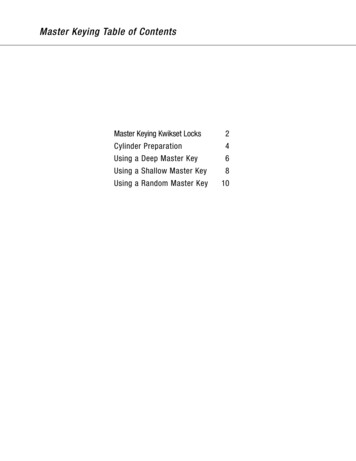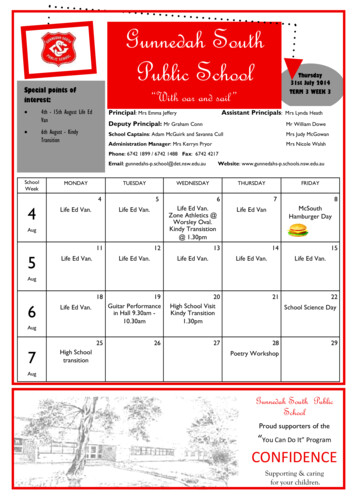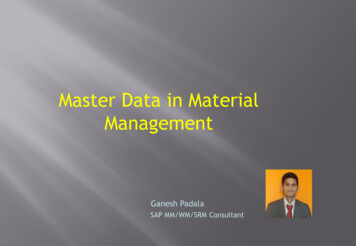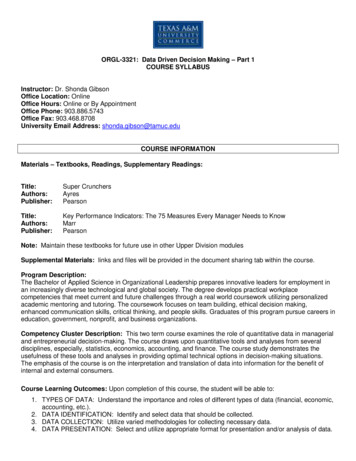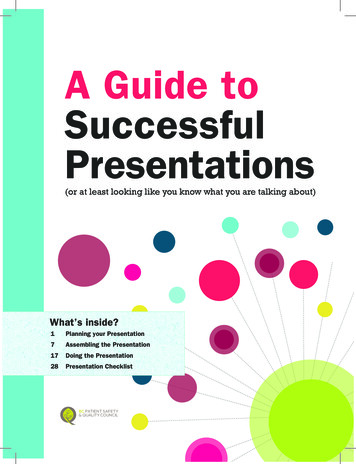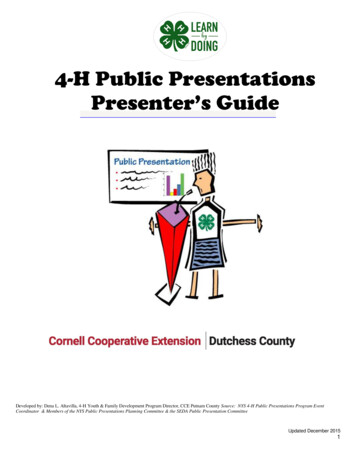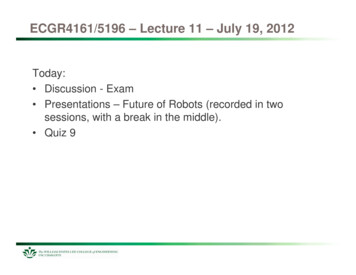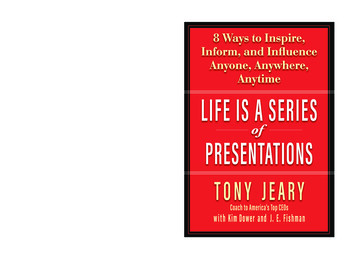
Transcription
— Dr. Stephen R. Covey, author of The 7 Habits of Highly Effective PeopleTaketheFpreseR E Entatiassessmentontonyjeaary.co tmLearn to make effective presentations that willunlock dramatic personal and professional successEverytimeyouspeak—whetherit’s �Presentationsa masterskill.Lifea SeriesofPresentations“Presentationsare a masterskill. Life Is a Series of Presentationsface-to-face,or frombehindlifea ignificantlyincreaseinfluenceand andis an aexcellenttool to ourabilityincreaseto nd sionally.”otherpeopleandeffectivelyyour message is the most— Dr. Stephen R. Covey, author of The 7 Habits of Highly Effective Peopleimportantfactorin yourlifelongas thebusiness— ePeoplePeople—StephenDr.StephenR. ctivePeopleworld’s premier presentation coach, Tony Jeary has trainedTakethexecutivesat effectivemore than500 work-classorganizationsin theF Rart eofLearnto tions.Now he maticpersonaland professionalsuccessththsstmsame techniquesand strategiewsFeasy-to-followF FtoEEnREyjeEeaeryh.ceneot tivepresentationsthatwill to you. Jeary’spprereprRREEmtips will help you gain confidence,ntsateimproveEverytimeyou speak—whetherit’s on the nce credibility,ssmsstmmface-to-face, or from behind a podium—your’reent tenrespect. Imagine having a greaterenabilitytotoatatt atnwithnytoyjemaking a presentation. Your ability to connectnaryayjejer.cya.cto ther people and effectivelycommunicateyourmostanyone,antimeand mportantfactorinyourlifelongsuccess. Known as the “Presentationsworld’sare a masterlifeskill. Life Isa Seriesof indexcellentincreaseyour influenceand ifemakinga presentation,so makeat youmorearethan500 work-classorganizationsthe art yabilitytotothat.connectconnectwithwithKencoauthor of[Tony}Yourcanhelpyoudo Blanchard,brings thosemakinga presentation.Yourabilitytowith— Dr. StephenR. Covey,author eandOneminuteManager andWhaleDone! isthemosttips will help you gain confidence, jancecredibility,andTONYTheRESULTSGuy orinyourlifelongsuccess.Knownasthebusinesske theF R E andLearnto nehavinga ntationcoach,TonyJearyhastrainedsenta move towardsPresentationMastery.unlockdramatic topersonaland eandanywhere.t atofexecutives at more than 500 work-class organizations s.thoseso make it ��Everytimeyoutouch a lifeNowyouare hemakinga presentation,KIM DOWER,a.k.a.Kim-from-L.A.,createsnationalpublicity sy-to-followeasy-to-followface-to-face,or froma”podium—your’re[Tony}can helpyou dobehindjust that.Blanchard, coauthor ofsame techniquesandstrategiewstoyou. Jeary’sKeneasy-to-followmedia trains high-profile celebrities TheandOnebestsellingauthors.Manager and Whale Done! makinga Cover design by BradtipsFolerpeopleand effectively communicate your message is the mostBack otherphotograph byKelly Y, TheGuy Register onlineat uccess.Knownasthebusinessinformation on this and other great books.FASTER!from such Fortune 500 companies as Ford, Wal-Mart, New York Life,EDS, ioncoach,TonyJearyhas trainedrespect.Imaginehavinga greaterQualcomm—howtomove towardsPresentationMastery. organizationsintheart EINFLUENCEtoINFORM,INSPIRE,andINFLUENCEeffective, winning presentations. Now he brings here.techniquesandanywhere.strategiewsto you. publicityJeary’s easy-to-followanyone,antimeandKIMsameDOWER,a.k.a. Kim-from-L.A.,creates nationalcampaigns andwill helpgain confidence,improvemedia trains high-profiletipscelebritiesand ty,and maximizeCoverdesign by Brad Foler20220104TJ kyouphotographby KellymakingCampbell“Every time you touch a lifeRegisterarea presentation,so makeitabilitygood!respect.Imagine havinga greaterRESULTSonline at www.simonsays.com for uyoudododojustjustthat.that.” ” on”this and other great books. to INFORM,KenKenBlanchard,Blanchard,coauthorofof nuteminuteManager Manager andandWhaleWhaleDone! Done! anyone,antimeandanywhere.The One minute Manager and Whale Done! “Every time you touch a life you are making a presentation, so make it good!TONYTONYJEARY,JEARY,TheTheRESULTSRESULTSGuy ,Guy world’stoptoptopCEOs—CEOs—Ken Blanchard,coauthor of[Tony} canhelp youdo just that.”coaches the world’sTONYJEARY,TheRESULTSGuy ,personallyCEOs—The One minuteManager andWhaleDone! orkLife,Life,EDS,EDS,andand2022 0104 TJminibuk.indd1 Newfrom such Fortune ��how to move towards Presentation Mastery.1/4/22 10:20 PM1/4/22 10:20 PMTONY JEARY, The RESULTS Guy , personally coaches the world’s top CEOs—from such Fortune 500 companies as Ford, Wal-Mart, New York Life, EDS, andQualcomm—how to move towards Presentation snational publicity campaigns gauthors.media trains high-profile celebrities and bestselling raphbyKellyKellyCampbellCampbellCover design by Brad FolerBackphotographby Kelly CampbellBackphotograph by Kelly ne at www.simonsays.com for moreRegisteronlineatwww.simonsays.comfor thergreatgreatbooks.books.information on this and other great books.information on this and other great NG2022 0104 TJ LIASOP minibuk.indd uk.indd 112022 0104 TJ LIASOP minibuk.indd 11/4/22 10:20 PM1/4/221/4/22 10:2010:20PMPM1/4/22 10:20 PM
LIFE IS A SERIESofPRESENTATIONSEight Ways to Inspire, Inform, and InfluenceAnyone, Anywhere, AnytimeTONY JEARYwith Kim Dower and J. E. Fishman
Life Is a Series of PresentationsCopyright 2022 by Tony Jeary High Performance Resources,LLC.All rights reserved. No part of this book may be reproducedor transmitted in any form or by any means, electronic ormechanical, including photocopying, recording or by anyinformation storage and retrieval system, withoutpermission in writing from the copyright owner.Published by Results Faster Publishing inFlower Mound, TXPrinted in the United States of America
TABLE OF CONTENTSIntroduction: Live and Learn. . . and Share It All .5PART I: WHY IT WORKSChapter 1: Every Time You are Touching a Life,You are Making a Presentation .11Chapter 2: Listen Up! . 13Chapter 3: Did You Say Something? . 17Chapter 4: A Miss Is as Good as a Mile . 23PART II: HOW IT WORKSChapter 5: Essential #1: Know Thy Audience . 27Chapter 6: Essential #2: Explain “Why” BeforePlanning How . 31Chapter 7: Essential #3: Conquer the Sum of AllFears . 33Chapter 8: Essential #4: Arm Yourself . 37Chapter 9: Essential #5: Build Bridges . 41
Chapter 10: Essential #6: Feel Good, Do Well . 45Chapter 11: Essential #7: Room to Breathe . 49Chapter 12: Essential #8: Flex for Success . 53PART III: MAKING IT WORKChapter 13: On Your Mark and Get Set . 59I– Involve the audienceP – Prepare your audienceR – Research and build a powerfulpresentation arsenalE – Explain the whyS – State ManagementE – Eliminate the unknownsN – kNow your audienceT – Tailor your presentation
INTRODUCTIONLive and Learn. . . and Share It AllSometimes, in rare quiet moments, I sitaround and wonder about the presentationsthat have shaped our world: King Solomondelivering his verdict in the most famouscustody dispute in human history, Jesustestifying before Pontius Pilate, Henry Vurging on his troops at Agincourt, the youngElizabeth begging Queen Mary to spare herlife in the aftermath of a Protestant plot,Thomas Jefferson exhorting his patrioticbrethren to fight for their freedom, John F.Kennedy inspiring a generation to reach themoon, and Martin Luther King, Jr. motivatinga million people on the Mall in Washington tofulfill his dreams of equality. Often thesepresentations have pertained to matters of life5
and death for masses of people. In some casesthey have decided the fate of the presentersthemselves.Your success in life depends upon howyou approach the millions of opportunitiesbefore you. The person who sleeps late everymorning, for example, might be well rested,but she surely isn’t going to be the early birdcatching the worm. For the purposes of thisdiscussion, however, I’m not concerned withwhether sleeping late is a good choice. I’mmore interested in one particular type offrequent opportunity: your chance to make animpression upon people who will affect thecourse of your life. What I spend my timeteaching to smart people just like you is thatthey don’t even realize the opportunities theymiss every day by not stopping to think abouttheir presentation strategy. And this is asignificant loss to all aspects of their wellbeing, from their monetary success to theirpersonal happiness.6
Life Is a Series of Presentations is theculmination of the past decade and a half ofmy work studying and helping others put intopractice the techniques for making greatpresentations. With the help of my coauthors, I will teach you that, while thedifferences between a good and badpresentation may seem intangible, many ofthem can in fact be quantified. For example,all people – whether presenting to aconference or to their spouse – must approachtheir task in a state of preparedness, mustmake others want to listen to them, and mustthen be responsive to their audience. Thesegoals sound so simple. Why don’t more folksachieve them? Well, it turns out that mostpeople don’t know the Eight EssentialPractices of Successful Presenters that you’lllearn in the second half of the book. Tounderstand why these practices will beeffective, however, you need to appreciate thethree core concepts that I’ll introduce in thefirst section: studies of the psychology ofpersuasion and influence; the principles of7
Neurolinguistic Programming, which enablespeople to practice what is called SensoryAcuity; and the organizational foundation thathelps you define what I call yourPresentation Universe.To one degree or another, in fact, I havetested the Eight Essentials before tens ofthousands of people. I use them in my ownpresentations to such an extent that they haveall become second nature. Of course, I havealso taught them to chief executive officers,to salesmen and to mid-level executives. Myniece even used some of them to get electedstudent council president! I know they work.Maybe the lives of these people don’tdepend on presentation skills. But theirlivelihoods and personal happiness very wellmay. And yours too. Because, as I hopeyou’ve begun to appreciate, life really is aseries of presentations. The better thosepresentations are, the better your life will be.8
PART IWHY IT WORKSUNDERSTANDING BEFORE ACTION
CHAPTER 1Every Time You are Touching a Life,You are Making a PresentationA presentation is the act of working tochange the content of another person’s mindat a particular time and place. If successfullyexecuted, presentations fulfill desiredoutcomes in the presenter’s audience—byenhancing a skill, changing or reinforcing anattitude, or imparting information. Goodpresentations require equal parts inspiration,skill, and hard work.Put a great deal of stock in preparation.Appearances are a major factor behind one’ssuccess in life. It is also important toremember that people have different preferredways of communicating and beingcommunicated to. Every time you touch a lifeyou are making a presentation, and the key toa successful impromptu presentation is to be11
prepared long before the occasion arises. Wehave more control over the impressionspeople form of us than we often realize.12
CHAPTER 2Listen Up!In Dr. Robert B. Cialdini’s insightful book,Influence: The Psychology of Persuasion, heconcluded that most successful techniques forinfluencing people fall into one of sixcategories: ReciprocationCommitment and ConsistencySocial ProofLikingAuthorityScarcity“Each of these categories is governed bya fundamental psychological principle thatdirects human behavior and, in doing so,gives the tactics their power,” he summarizes.In other words, the techniques he studiedsucceed because they exploit essential13
qualities that have been ingrained in allhumans. Before you conclude that you areabove these influences, you may want toconsider that a recent study found that thehuman and mouse genomes containcounterparts on 99 percent of theirchromosomes. If, like the rest of us, you’re 99percent mouse, then you are that much morelike other humans and most certainly just assusceptible as the next guy to Dr. Cialdini’sinfluences.Our receptivity to messages oftendepends upon certain core biases that areembedded in the human psyche. We love andrespect Consistency in ourselves and others—and we loathe inconsistency. When it comesto influence, there’s nothing like the Likingprinciple.We are trained from birth that whensomeone does us a favor, we have anobligation to repay. When we understandwhat makes people receptive to influence, weare in a position to be a motivating force in14
their lives. The success of our presentationsshould not be a random event, but the resultof conscious actions.15
CHAPTER 3Did You Say Something?Neurolinguistic Programming (NLP) is along-winded way of describing the study anduse of language as it impacts the brain and,therefore, our behavior. Like manyintellectual disciplines, NLP can get verytechnical, and many aspects might not applyto what we endeavor to do here. By the end ofthis chapter, you should have an appreciationfor the following broad principles of NLP:1. We must respect differentperspectives. People view the worlddifferently, depending upon their lifeexperiences: what they’ve read, seenand felt, their religious experiences,their formal education, what theirparents have taught them, wherethey’ve lived and continue to live,and what kind of people and17
environment they’ve been exposedto. As a result of these variedexperiences, different people usedifferent – and sometimes conflicting– frames of reference to analyze andrespond to what’s going on in theworld. So, while we may not agreewith the way some other people seethe world, we must respect theirviews as having been legitimatelyarrived at based upon what theyknow and don’t know of life. If weare to communicate effectively, wemust do justice to these differences,because such an understandingmakes us more flexible and,therefore, more effective.2. Our communication goes beyond thewords we choose. The way we saythings and the way we receiveinformation are as important as theactual words we use. While weshould never lose sight of why we are18
communicating with our audienceand what we are communicating, wealso must always be conscious ofhow we are communicating. Ourverbal vocabulary is just one piece ofthis puzzle.3. When we become like our audience,our message is better received. Aswe learned in Chapter 2, people aremuch more receptive to messagesfrom those whom they consider to belike themselves. As a consequence,the presenter who appears to besimilar to his audience has a muchgreater opportunity to achieverapport. So, we should strive tocreate sameness with our audience.4. People receive informationdifferently. While most people appearto have all their senses, it turns outthat individuals have differentpreferences for receivinginformation. If you were bilingual19
and went to a foreign land where youknew the language, you would likelycommunicate better in the nativetongue than by persisting in English.So it is with the ways people receiveinformation. Once we discover theirpreference, we must endeavor toadjust the “language” of ourpresentation for optimalunderstanding.5. We also reject information basedupon subconscious personalpreferences. Just as people havepreferences for the way they wish toreceive information, they haveinclinations about what informationthey would prefer not to receive at all– or will only agree to receive in analtered way. By understanding theway our audience filters information,we have another means to adjust ourapproach for better rapport.20
6. Finally, generalizations and otherloaded phrases can work against ourmessage. We must choose our wordswith precision and understand whichwords and phrases hamper or defeatour ability to communicateeffectively. Clarity of language canbe as important as clarity of purpose.We call the full employment of one’ssenses Sensory Acuity. Our entire perceptionof the world is a reflection of what we absorb(or have absorbed in the past) through ourfive senses. Our communication goes beyondthe words we choose. When we become likethe audience, our message is better received.People receive information differently.We also reject information based uponsubconscious personal preferences.Generalization and other loaded phrases canwork against our message. The person withthe most flexibility has the best chance ofachieving the outcome he or she desires. Youshould respect the way the other person views21
the world. The substance of yourcommunication is the response it generates.The words we use to describe things havedifferent meanings to different people.The mind and body influence each other.The more precise a person is incommunication, the more successful he or shebecomes. Any time we are making apresentation—whether it’s to an audience ofhundreds or to a single individual—we areengaged in a two-way communication.22
CHAPTER 4A Miss Is as Good as a MileWe have seen that the typical person’slife is a series of presentations and that, onoccasion these presentations might evenpertain to matters of life and death. So youknow by now that presentations are importantto people’s lives and to their success, nomatter how they define success. Decades ago,Dale Carnegie observed that “even in suchtechnical lines as engineering, 15 percent ofone’s financial success is due to one’stechnical knowledge and about 85 percent isdue to skill in human engineering – topersonality and the ability to lead people.”“Leadership is the ability to teach peopleand organizations to surpass themselves.”Most of the time, stuff doesn’t just happen tous—we make it happen by what we do and bythe way we are. Our goal as presenters oughtto be unconscious competence—or to be23
operating in automatic mode. Marginallycompetent presenters don’t fully appreciatethe critical impact that presentationeffectiveness can have on their success or thatof their business.Presentation Mastery results in adisciplined user of advanced processes andtechniques that are effective virtually 100percent of the time. A good presentationleverages our most likable personality traitswith our polished skills to invigorate thecontent of our message. Pledging to addressyour insecurities head-on will empower youto fully employ all the tools and practices ofthe successful presenter. Define yourPresentation Universe conservatively at firstby focusing on those presentationopportunities that will create the greatestimpact on your life.Next, you will learn specifictechniques for turning yourself into a MasterPresenter.24
PART IIHOW IT WORKSEVERYDAY ESSENTIALS OF SUCCESSFULINTERACTION
CHAPTER 5Essential #1: Know Thy AudienceIt may be hard to believe that an intelligentperson who has already achieved greatsuccess and who, in a certain sense, speaksprofessionally would not have paused toreflect on the fact that a teenager’s attentionspan is not the same as an adult’s is. Yet thisis a true story, and the real-life anchorman didmake this fatal mistake. The fact is anyonemight have been the victim of this story.Failure to know one’s audience is among themost common and avoidable mistakes thatpresenters make.The DISC Profiler is an acronym forthe initials of each personality type. TheDISC illustrates the fact that two major forcesact within each of us—forces that can roughlybe plotted on a continuum. Many peopleshow combinations of these personality types.27
As a presenter, you are most interested inwhich factor dominates your audience’spersonality.28
The Driver/Dominant style is driven bya need to be in charge and achieve. They aregoal-oriented go-getters. If you want to relatewell with them, don’t waste their time, beorganized and to the point, and appeal to theirsense of completion and execution.The Influencer/Interactive style isfriendly, enthusiastic, and likes to be wherethe action happens. They thrive on admirationand compliments and are typically optimisticand charismatic. If you want to relate wellwith them, support their ideas and opinionsand get to know them on a social level.The Steady/Supportive style is warmand nurturing and are very loyal. Theirrelaxed disposition makes them approachable.If you want to relate well with them, earntheir trust and show sincere interest and don’tback them into a corner. They want approval.The Cautious/Compliant style isanalytical, persistent and loves to solveproblems. They are detail-oriented and enjoy29
perfecting processes. They have highexpectations of themselves and others whichcan make them critical at times. If you wantto relate well with them, be sensitive to theirtime, give them data and details, and besystematic, logical, and well-prepared.Understanding people and how theyrespond can be one of the most significantfactors in your personal and professionalrelationships.Once you grasp the composition of youraudience with regard to personality type, youare in a better position to plan yourpresentation to suit their preferences.30
CHAPTER 6Essential #2: Explain “Why”Before Planning HowThe single most powerful thing you can do toconvince your audience of something is toprovide a compelling reason why they shoulddo what you suggest (or believe what yousay). Sometimes our motivation comes fromoutside ourselves and sometimes it comesfrom within. Your audience, like all humanbeings, is driven by basic subconsciouswants. In order to reach them mosteffectively, you must tailor your presentationin a way that addresses those desires.Organizations don’t make decisions—people do. The 3-D Outline on thefollowing page enables us to drill down intoour own motivations and those of ouraudience as a means of taking ourpresentation where it ought to go.31
By writing down these whys, we forceourselves to address the fundamental desiresof our audience. The result may seemmiraculous: We will get what we want fromour presentation because we have theaudience what they wanted from ourpresentation.32
CHAPTER 7Essential #3: Conquer the Sum of All FearsAccording to an entry I once saw in TheBook of Lists, Americans rank heights, insectsand bugs, financial problems and deep wateras their second, third, fourth and fifth greatestfears. Sickness is number six. Death isnumber seven. Number one is the fear ofspeaking before a group.From the perspective of the presenter,most of us are familiar with the symptoms ofthis fear: that pit in the bottom of ourstomachs or the twitching lip or the tighteninglarynx or the trembling leg or increasingdryness in the mouth and throat. To ouraudience, this fear reveals itself as a quakingvoice or inconsistent vocal tone, as negativeor inappropriate body language, andultimately as a failure to achieve rapport withthe audience because we are so absorbed in33
our own anxiety that we disconnect. Evenseasoned professionals can manifest thiscondition when they work under unfamiliarcircumstances or enter a situation thatpresents unexpected distractions.Nervousness with regard to publicspeaking derives from what Carl Jungconcluded was the hard-wired mother of allfears: fear of the unknown. By reducing thesurprise element, we can have a significantimpact on the smoothness of our delivery.Also, by turning unknown quantities intoknown quantities, we can overcome theanxieties and uncertainties that undermineany presentation. The effectiveness of anypresentation depends greatly upon ourconfidence in the quality and appropriatenessof that presentation’s content. Once wereplace what we imagine the presentationenvironment is going to be with what we nowsee it will be, much of our stress subsides.Know the what-ifs and take ownershipof your surroundings. Practice your34
presentation at every opportunity. I guaranteeyou will feel more confident in yourpresentations before you know it.35
CHAPTER 8Essential #4: Arm YourselfIf life is a series of presentations, you couldspend your life preparing each presentation insequence – but then you wouldn’t have a life.Nor would you be ready for the impromptupresentations that we are frequently calledupon to make. Better to be prepared for anycontingency by constantly keeping an eye outfor stand-alone concepts, stories or quotationsthat might bring value to given situations oraudiences. That’s exactly what a MasterPresenter like my friend Zig Ziglar did whenhe was alive. Years ago, I got to know Zigand his son-in-law, Jim Norman, who thenran his entire organization. Jim observed thatZig carries in his head what he called a“mental jukebox” of about 1,500 stories thathe can access at a moment’s notice, the way ajukebox pulls a pre-recorded song out of a37
slot at the press of a button. Undoubtedly thisimpressive reserve of material that is alwaysnearly at the tip of his tongue has helped himbecome one of the most successful presentersof all time. And, though Zig Ziglar is aprofessional speaker of supremeaccomplishment, there is a
— Dr. Stephen R. Covey, author of The 7 Habits of Highly Effective People Learn to make effective presentations that will unlock dramatic personal and professional success e E n t m Everytime you speak—whether it's on the phone, face-to-face, or from behind a podium—your're making a presentation. Your ability to connect with
